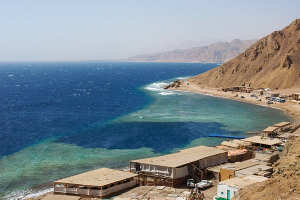Top 12 Most Fascinating Pyramids in Egypt
The pyramid is without a doubt the most famous symbol of Egypt throughout history. The brick constructions with a pyramid pattern are iconic and significant in ... read more...Egyptian culture, and they are now among the country's top attractions. Historians have identified approximately 100 pyramids in Egypt, the majority of which come from the Old Kingdom and Middle Kingdom periods of Egyptian history. Along with the well-known Great Sphinx and the Pyramid of Khufu, which most tourists will photograph while in Egypt, take a closer look at some of the country's lesser-known, but no less spectacular, pyramids.
-
The Pyramid of Khufu is the only one of the Seven Ancient Wonders of the World that is still standing. The Pyramid of Khufu, which is situated in the heart of Giza, also happens to be the biggest pyramid in Egypt. The building is also known as the Pyramid of Cheops and the Great Pyramid of Giza. According to historians, the Pyramid of Khufu was constructed about 2560 BC, and it is estimated that it took 10 to 20 years to complete.
The pyramid got its name because it is thought to be the tomb of Khufu, the Egyptian Pharaoh of the Fourth Dynasty. The magnificent pyramid building is claimed to have been designed by Khufu's vizier Hemiunu. More than two million blocks had to be brought from local quarries during construction, and the principal materials utilized included limestone, granite, and mortar. The Pyramid of Khufu stands 139 meters (455 feet) tall now, although erosion means it may be shorter than it was when it was built.
Despite the fact that only 300 tickets are sold to tourists each day, you can enter the Pyramid of Khufu. If you're fortunate enough to get a ticket, you'll enter by the north face, roughly 15 meters (50 feet) above the earth. You will pass through several of the pyramid's interior rooms as you ascend a tunnel. The King's Chamber, the Grand Gallery, and the Queen's Chamber are must-see attractions. Aside from the King's Chamber, there are five Relieving Chambers that weren't meant to be seen and are solely there to keep the King's Chamber from collapsing or changing over time. Keep in mind that most of the historic treasures that were deposited within the pyramid at the time of Khufu's death were stolen centuries ago, and what remains in modern history has been relocated to museums all around the world as you tour the Pyramid of Khufu.
Location: Al Haram, Nazlet El-Semman, Al Giza Desert, Giza Governorate 3512201

Great Pyramid of Giza | The Majestic Pyramid of Khufu - Pyramids of Giza Tickets 
touropia.com -
The Pyramid of Khafre is situated next to the Pyramid of Khafu. Even though the Pyramid of Khafre is a little bit smaller, it is frequently referred to as the Khafu's sister building. The Pyramid of Khafre, which was built around 2570 BC, just a decade after Khafu, belonged to the Fourth Egyptian Dynasty. But the Pharaoh Khafre, also known as Chefren in history books, was intended to have his final resting place at the Pyramid of Khafre.
Although the Pyramid of Khafre is really smaller than the Pyramid of Khafu, at first impression it appears to be larger. That's because Khafre has steeper sides and a more pointed top because it is built on bedrock, giving it a significant height advantage. The building of the Pyramid of Khafre is a testament to the amazing engineering and design skills of the ancient Egyptians, especially when it comes to selecting limestone pieces that ensure structural stability. The stones of the Pyramid of Khafre are larger at the base and become smaller as it gets closer to the top.
However, one notable flaw in Khafre's pyramid's construction is that the four corners aren't exactly aligned, resulting in the apex having a small twist rather than pointing straight up to the sky.
The Pyramid of Khafre, unlike most pyramids, has two independent entrances. Several chambers inside the pyramid are open to the public for exploration. You should see the burial room, which has enormous limestone beams spanning the ceiling. There are also sunken areas on the floor of several chambers, which would have housed a sarcophagus.The larger complex that includes the Pyramid of Khafre has some of the most well-known buildings in all of Giza. The Great Sphinx, the Mortuary Temple, the ruins of a satellite pyramid, and the Valley Temple are just a few of the numerous monuments in the vicinity that are worth seeing.
Location: X4GJ+F93, Al Haram, Giza Governorate 3512201

The Great Sphinx and the Pyramid of Khafre (article) - Khan Academy 
Egypt Time Travel -
Dahshur is home to the Red Pyramid, sometimes referred to as the North Pyramid. The red limestone used in building it gave it its name. The Red Pyramid has the largest base of any pyramid in Egypt, second only to the Great Pyramid of Khufu at Giza. However, at 104 meters, it is considerably shorter due to its sides' 43-degree slope (341 feet). It is currently Egypt's third-largest and fourth-highest pyramid. It was the first successful real, smooth-sided pyramid constructed in Egypt, even though it was no longer the largest. It also introduced the widely recognized Giza style of pyramids.
The Red Pyramid was the second (or possibly third) pyramid built by Pharaoh Snefru (2575-2551 B.C.) and was most likely begun during his twenty-second and twenty-ninth years in power. It took roughly 17 years to build, according to numerous inscriptions found on some of the stone blocks. It stands 105 meters (345 feet) tall and has three rooms.
The entrance is located on the north-facing side, just like the majority of Egyptian pyramids. This opens a corridor that is 60 meters (200 feet) long. A short corridor that leads to the first room is located at the foot of this passage. The height of this chamber is roughly 12 meters (40 feet).
The second, nearly identical-sized chamber is accessible from the southern end of the first chamber by a short hallway. This chamber is located just beneath the summit of the Red pyramid, in contrast to the majority of pyramid chambers. These first two chambers are located on the ground. An entrance in the wall is cut at the southern end of this second chamber. The final chamber is reached through a new wooden staircase. This chamber is built into the masonry and is higher than the preceding two. It stands around 15 meters (50 feet) tall and is thought to be the burial chamber. Pharaoh Khufu, the son of Pharaoh Snefru, is said to have buried his father here. However, no human remains have been discovered.A unique pyramidion, also known as the capstone, has been discovered, rebuilt, and is now on exhibit. However, since its degree of inclination differs from that of the Red pyramid, it is questionable whether it was ever truly used. East of the pyramid is also the remnants of a mortuary temple. This is noteworthy because Snefru was the first to exploit the Egyptian temples' east-west alignment to coincide with the sun's movement.
Until recently, it was impossible to go securely to Egypt's Dashur region. As a result, the Red Pyramid is not as popular as the other pyramids on the Giza Plateau. This makes coming here a lot more pleasurable. In addition, unlike most other sites, this pyramid can be entered without restriction. As a result, without the crowds and with open access, a visit to The Red Pyramid is a once-in-a-lifetime opportunity to see one of Egypt's most famous pyramids up close.
Location: Dahshur necropolis in Cairo

Travel to Egypt 
Red Pyramid of Dahshur, Cairo, Egypt - Windows 10 Spotlight Images -
Dahshur is Egypt's most historically significant pyramid field after Giza and Saqqara. The Bent Pyramid, located in the center of Dahshur, was built around 2600 BC during the reign of Pharaoh Sneferu of the Old Kingdom. The Bent Pyramid got its name from the way it was built. The structure's base rises from the desert floor at a 54-degree angle, whereas the top half rises at a 43-degree inclination. As a result, the pyramid seems twisted or titled to one side. The pyramid's formal name is the Pyramid of Sneferu, or the Southern Shining Pyramid.
Although there are many ideas about why the pyramid is crooked, few scholars think that it was an accident. Instead, the alteration in angle may be linked to the pharaoh's deteriorating health, which made it necessary to finish the pyramid sooner, or it may have been a precaution against an impending collapse brought on by the steep angle of the initial building. It could potentially be a result of the neighboring Meidum Pyramid's collapse, which was mostly caused by its abnormally steep slope.
Location: Q6R5+5PG, Badrshein, Giza Governorate 3300001

Bent Pyramid - Wikipedia 
Bent Pyramid of Sneferu - Egypt Tours Portal -
A region named Saqqara, which is only 25 kilometers (15 miles) south of Cairo, has a pyramid field that is home to some of the earliest pyramids in Egyptian history. The Step Pyramid of Djoser is one of the most notable, usually regarded as the earliest cut-stone building in the world, and serves as a vital landmark for Egyptologists, archaeologists, and architects alike. Imhotep, the vizier of Pharaoh Djoser, began building the Step Pyramid of Djoser during the Third Dynasty, and it was finished about the 27th century BC.
When compared to the usual representation of an Egyptian pyramid, the Pyramid of Djoser clearly differs in appearance. That's because Djoser is a step pyramid rather than having smooth sides. The terraces were constructed one on top of the other. Technically, the design consists of six mastaba stacks, with the last mastaba being smaller than the previous five.
The entire Djoser structure was enclosed by a limestone wall with 14 doorways built into it. However, there was only one entrance, and the remaining doors could have been just decorative or a ruse to fool passersby into allowing unauthorized admittance. Other notable characteristics of Djoser include a large trench that surrounds the complex and elaborate stone pillars in the roofed colonnade hallway that were carved to resemble reed bundles.
The Djoser complex's South Court is a vast expanse built to isolate the pyramid from the South Tomb. The South Court still has curved stones linked with the Heb-sed festival, which were placed there to enable the pharaoh to retain his dominion over Egypt after his death. Although there are numerous speculations regarding what was stored in the South Tomb, there is no confirmation of what was deposited in its three chambers, which are exquisitely designed and possibly the most magnificent portion of the entire complex.
Location: Al Giza Desert, Giza Governorate 3352001
Step Pyramid of Djoser, Sakkara - Holiday and Trips 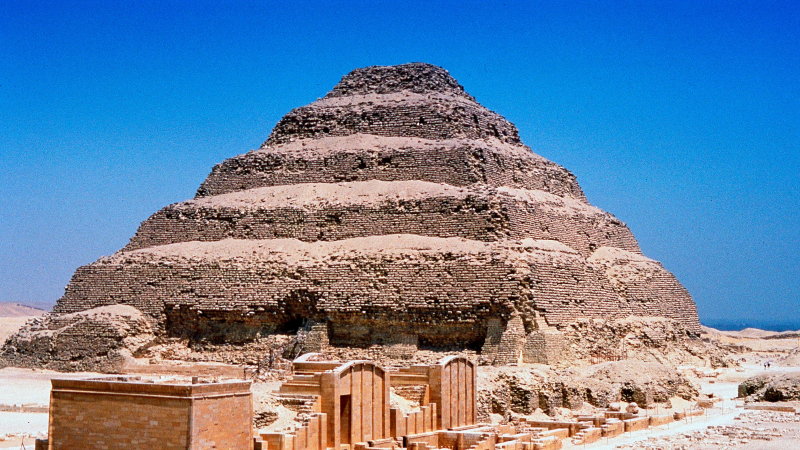
Step Pyramid of Djoser - Egypt's Oldest Pyramid - ThoughtCo -
The Pyramid of Khufu, the Pyramid of Khafre, and the Pyramid of Menkaure are the three main monuments that are usually mentioned when someone mentions the Pyramids of Giza. The Pyramid of Menkaure is by far the smallest of the three. However, it plays a significant role in Giza's design, and if you're in the vicinity, it's definitely worth a trip.
This 65-meter-high pyramid was built in 2510 BC for Pharaoh Menkaure of the Fourth Dynasty (213 feet). This makes the Pyramid of Menkaure nearly half the height of its neighbors. The materials used in the construction of the Pyramid of Menkaure were red granite in the pyramid's base and limestone near the summit. Because parts of the granite in the pyramid were left unpolished, archeologists and historians believe the pyramid was unfinished.
You might observe that one side of the Pyramid of Menkaure is lacking a vertical strip of stones if you were to gaze at it now. Surprisingly, that is the end outcome of Saladin's son's determined efforts to destroy the pyramid in the 12th century. Fortunately, the procedure was time-consuming and expensive, and it was finally dropped. The lost stones serve as a poignant reminder of both the endurance of the pyramids and the value of maintaining these kinds of historical sites.
You'll descend stairs to enter a corridor as you enter the Pyramid of Menkaure. The first antechamber is then reached, followed by sculpted reliefs in the walls and an opening into another chamber. As you enter the main sequence of rooms, you'll have a unique view of the pyramid's arched pinnacle, a breathtaking sight that you have to see to believe.
Location: the Giza Plateau in the southwestern outskirts of Cairo
The Pyramid of Menkaure - Pyramids of Giza Tickets 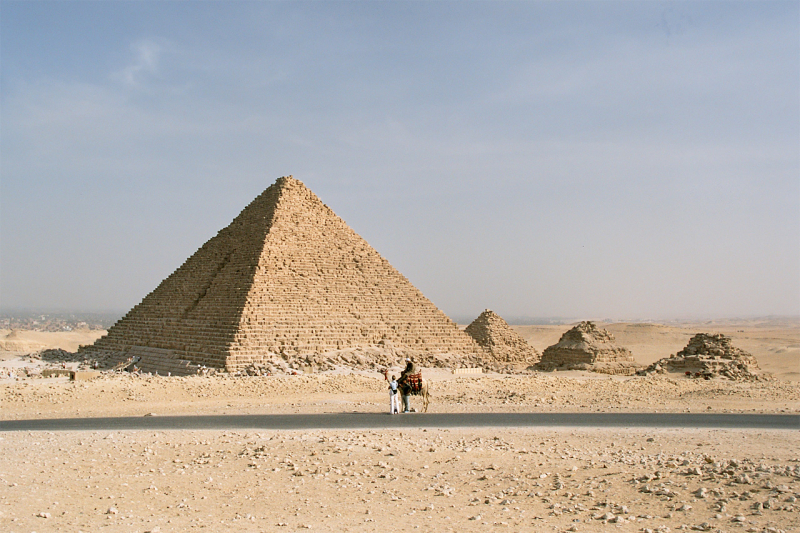
Pyramid of Menkaure - Wikipedia -
Meidum, about 100 kilometers (60 miles) south of Cairo, has a pyramid that is nearly as tall as Giza's Pyramid of Menkaurein. Meidum was built during Egypt's Third Dynasty, making it older than the Pyramids of Giza. Meidum was created for Huni, the final pharaoh of the Third Dynasty. You can easily tell that pyramid construction was not yet a science at this point. Meidum was initially designed as a step pyramid with terraces to make construction easier for each level, rather than with smooth sides. The outer layer was also made of sand rather than stone, which may have contributed to the pyramid's eventual collapse.
Meidum contains three distinct tiers or phases as of right now. El-heram el-kaddaab, or faux pyramid, is the term used by many Egyptians to describe it since it lacks a high apex at the top. The Pyramid of Meidum is still unquestionably worthwhile, nevertheless. You can access the incomplete burial chamber after walking along a passageway that has been physically supported by wooden beams. A number of mud brick-constructed mastabas, or tombs, surround the pyramid itself. These smaller tombs include tunnels that ancient thieves used to steal from the graves; several of them resemble the base of a pyramid.
Location: 95Q5+82R, El Wasta, Beni Suef Governorate 2753212

Pyramid of Meidum - ecreyes/ Flickr 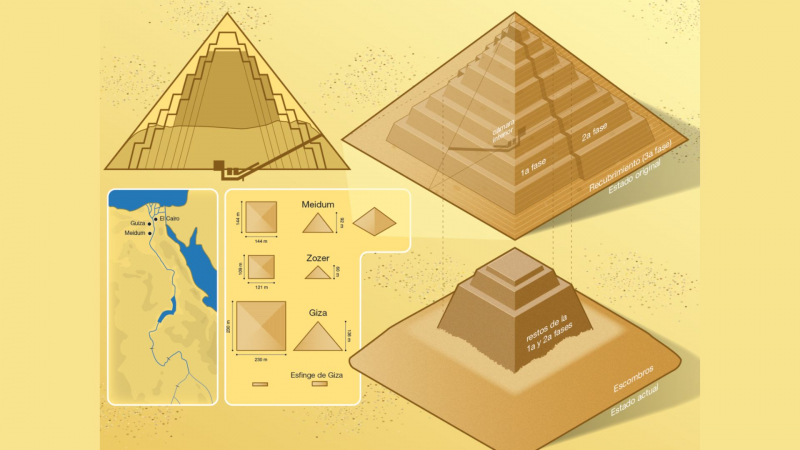
Pyramid of Meidum. by Francisco González y García on Dribbble - Pinterest -
The Pyramid of Unas is located in the Saqqara area. The Pyramid of Unas was constructed in the 24th century BC for Pharaoh Unas, the final monarch of the Fifth Dynasty. Although the Pyramid of Unas was originally 43 meters (141 feet) tall, it is now mostly damaged.
The fact that the Pyramid of Unas was the first of its kind to contain what is now known as Pyramid Texts is one of the reasons for its significance. Magical inscriptions that were intended to guard the pharaoh against harm in the afterlife were etched directly into the walls. Following Unas, several more pharaohs followed suit, establishing a widespread pattern among Egyptian kings. In fact, it's thought that the Book of the Dead and the later Coffin Texts drew inspiration from the Pyramid Texts.
The Pyramid of Unas, built of limestone, was unearthed in the 19th century by Western explorers, who uncovered a mummy in the tomb. Historians aren't certain that the remains belonged to Unas because they could have belonged to a later noble.
Location: between the complexes of Sekhemket and Djoser, in North Saqqara
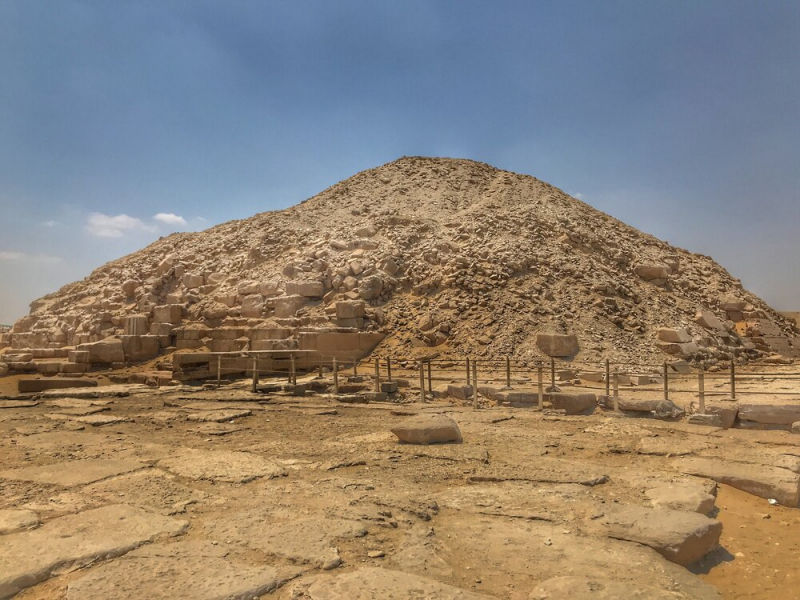
The Magical Pyramid of Unas at Saqqara - The Not So Innocents Abroad 
Phil/ Flickr -
Another significant building situated in Saqqara's pyramid fields is the Pyramid of Teti. Teti was the second of the Egyptian pyramids to have Pyramid Texts or magic spells written or carved into the walls of the tombs, and it was constructed between 2345 and 2333 BC during the Sixth Dynasty. The Pyramid of Teti was discovered through investigation and excavation in the late 19th century to consist of two smaller pyramids most likely built for the queens of the Pharaoh Teti, a funerary temple, and one large pyramid for the king's burial.
The Pyramid of Teti appears to be utterly damaged from above ground, and it could easily be mistaken for a tiny hill rather than a pyramid building. Fortunately, the underground corridors and chambers are in considerably better shape and have been remarkably preserved over time. Despite the loss of the valley temple, the Teti's Room of the Greats, the interior chapel containing five different statues of Pharaoh Teti, the long descending hallway leading to the burial chamber, the funerary apartments for the pharaoh, and the Pyramid Texts inscribed on the walls can still be seen.
Location: Central Saqqara just south of the 1st dynasty mastabas and northeast of Userkaf's pyramid
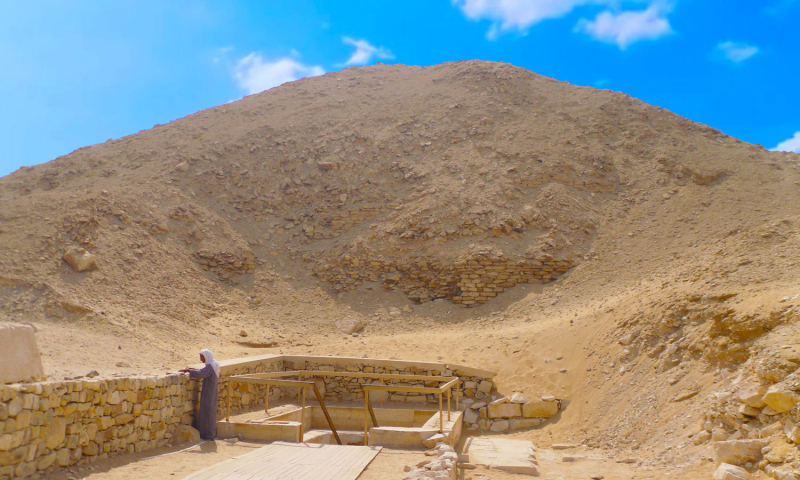
Pyramid of Teti Facts - Egypt Tours Portal 
touropia.com -
The Pyramid of Hawara, built by Amenmehat III, the sixth Pharaoh of the 12th Dynasty, is located three hours' drive south of Cairo. The Pyramid of Hawara was built, according to historians, in 1850 BC, making it roughly 3,865 years old now. Because it appears far darker than other Egyptian pyramids from the same era, the Pyramid of Hawara is frequently referred to as the Black Pyramid. The pyramid's dark color is a result of its construction from brick stones and limestone covering.
The Pyramid of Hawara was approximately 60 meters (200 feet) tall when it was first built, yet erosion and desert sands have diminished its height slightly over time. Pharaoh Amenmehat III did not build the first pyramid, Hawara. His first, Dashur, was a failure and collapsed shortly after construction. As a result, the Pyramid of Hawara is constructed at a lower angle to avoid collapse. Even this second pyramid, however, is now little more than an eroded, vaguely pyramidal mound of mud brick.
The Pyramid of Hawara, which is still standing but no longer has a sharp pinnacle, is noteworthy for how it started to recognize and attempt to fool tomb thieves. In order to confuse and frustrate potential robbers in ancient Egypt, the Pyramid of Hawara included corridors that were laid out in a labyrinthine layout.
Location: about 9 kilometers east of the oasis of Faiyoum
The Pyramid of Hawara - Egypt Fun Tours 
Hawara Pyramid (Al Fayyum) - TripAdvisor -
The Pyramid of Userkaf, one of the Saqqara pyramids, was erected between 2494 and 2487 BC while Userkaf, a Fifth Dynasty pharaoh, was in power. The native name for the pyramid, El-Haram el-Maharbish, translates directly to "Heap of Stone," which is far from lyrical. Userkaf truly has a core of debris, and what was left over was dressed stone. The Pyramid of Userkaf is now in ruins and resembles a sand conical hill rather than a genuine pyramid.
The Pyramid of Userkaf was a construction that differed from the Fourth Dynasty pyramids and inspired the later Fifth Dynasty pyramids in many respects. Userkaf did keep the complex's traditional high wall and the causeway connecting one tomb to the main pyramid. However, it also included novel concepts such as a north-south axis orientation and the placement of a small chapel outside the pyramid rather than inside.
Rameses II repaired the Pyramid of Userkaf and utilized it as a cemetery more than 1,500 years after it was built. In more recent history, the pyramid's entrance was discovered in 1831, but it wasn't until 1839 that anyone actually went inside the pyramid after discovering a tunnel that had probably been excavated by tomb raiders and provided simple access to the interior.
Location: Saqarah, Badrshein, Giza Governorate

Pyramid of Userkaf - Wikipedia 
The pyramid of Userkaf - The Pyramids of Egypt -
The Pyramid of Lahun, also known as el-Lahun, was built approximately 1180 BC during the reign of Senusret II of the 12th Dynasty. El-Lahun means "Mouth of the Canal," because it was located right on the water. This pyramid is currently in ruins, and the internal causeways and corridors are mostly ruined and inaccessible. Even in the 1840s, when explorers were eager to unearth and describe as many Egyptian pyramids as possible, British archeologist Sir Flinders Petrie spent months just finding the entrance to the pyramid itself.
Despite the fact that the north side of the building is usually the entry due to religious reasons, the entrance to the Pyramid of Lahun was concealed in the courtyard on the south side of the building. One of the first pyramids in Egypt where safeguarding the tomb's contents and ensuring its security came before following established customs is the Pyramid of Lahun.
Although there are no remains, it is thought that the Pyramid of Lahun's exterior was covered in ornamented granite. The pyramid's base was effectively built from existing natural limestone, which made the building simpler than usual. The peak of the construction was most likely formed by a smaller black granite pyramid that was positioned there.
Location: Faiyum
touropia.com 
Egypt's Lahun Pyramid opens to the public - Condé Nast Traveller Middle East































